Strategic HRM: Multi-Generational Workforce and Ethical Practices
VerifiedAdded on 2023/04/21
|5
|1460
|143
Report
AI Summary
This report provides an overview of human resource management (HRM) strategies, highlighting the importance of HRM in achieving a competitive advantage. It addresses the challenges of managing a multi-generational workforce, including recruitment, performance management, training, and mentoring. The report also discusses the role of HRM in protecting whistleblowers and ensuring ethical practices within an organization, referencing examples such as Google's approach to employee engagement and the Google China search engine controversy. It emphasizes the need for organizations to adapt their HRM practices to address the unique needs and expectations of different generations, and to foster a culture of transparency and ethical behavior. Desklib provides students access to similar solved assignments.
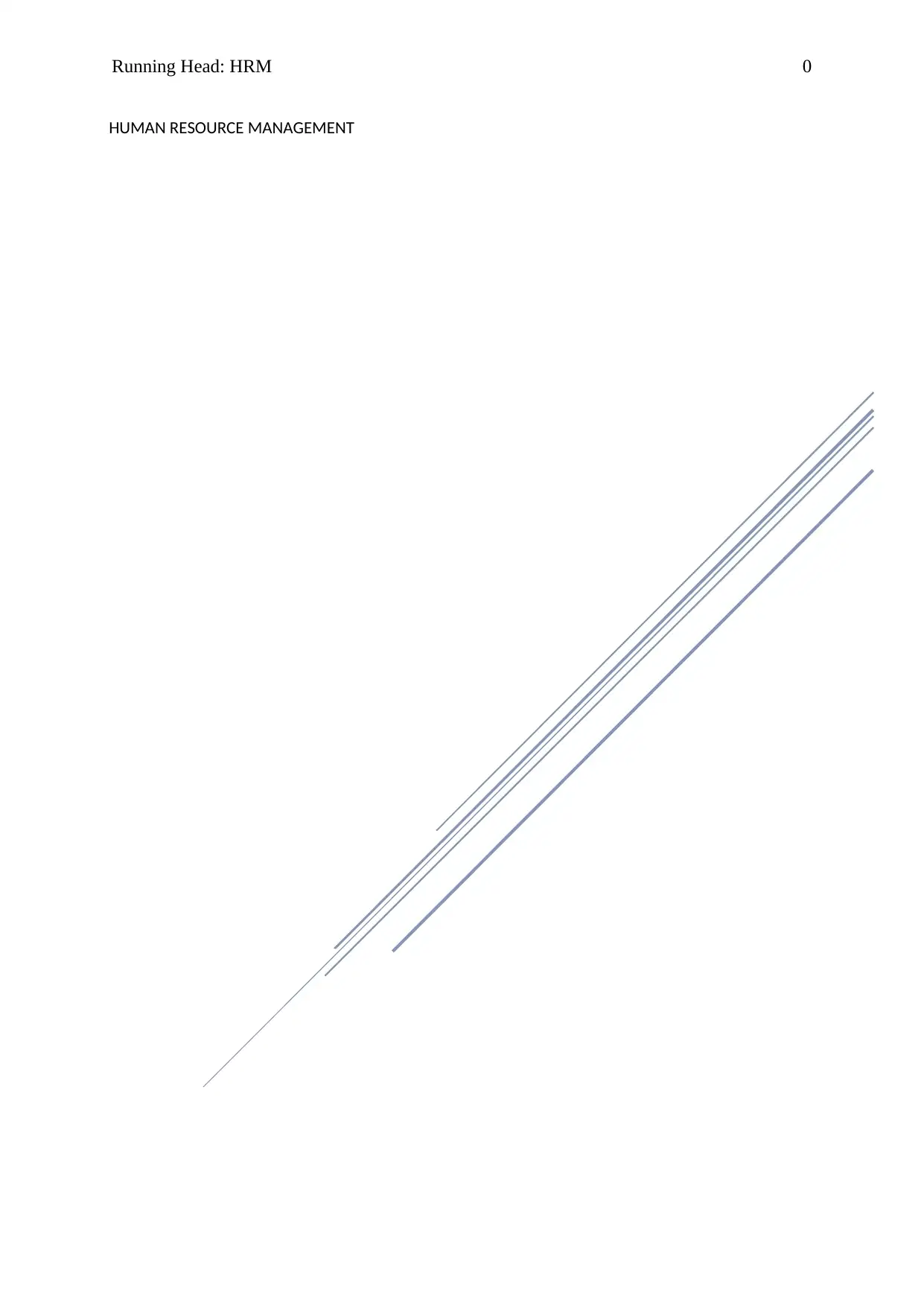
Running Head: HRM 0
HUMAN RESOURCE MANAGEMENT
HUMAN RESOURCE MANAGEMENT
Paraphrase This Document
Need a fresh take? Get an instant paraphrase of this document with our AI Paraphraser
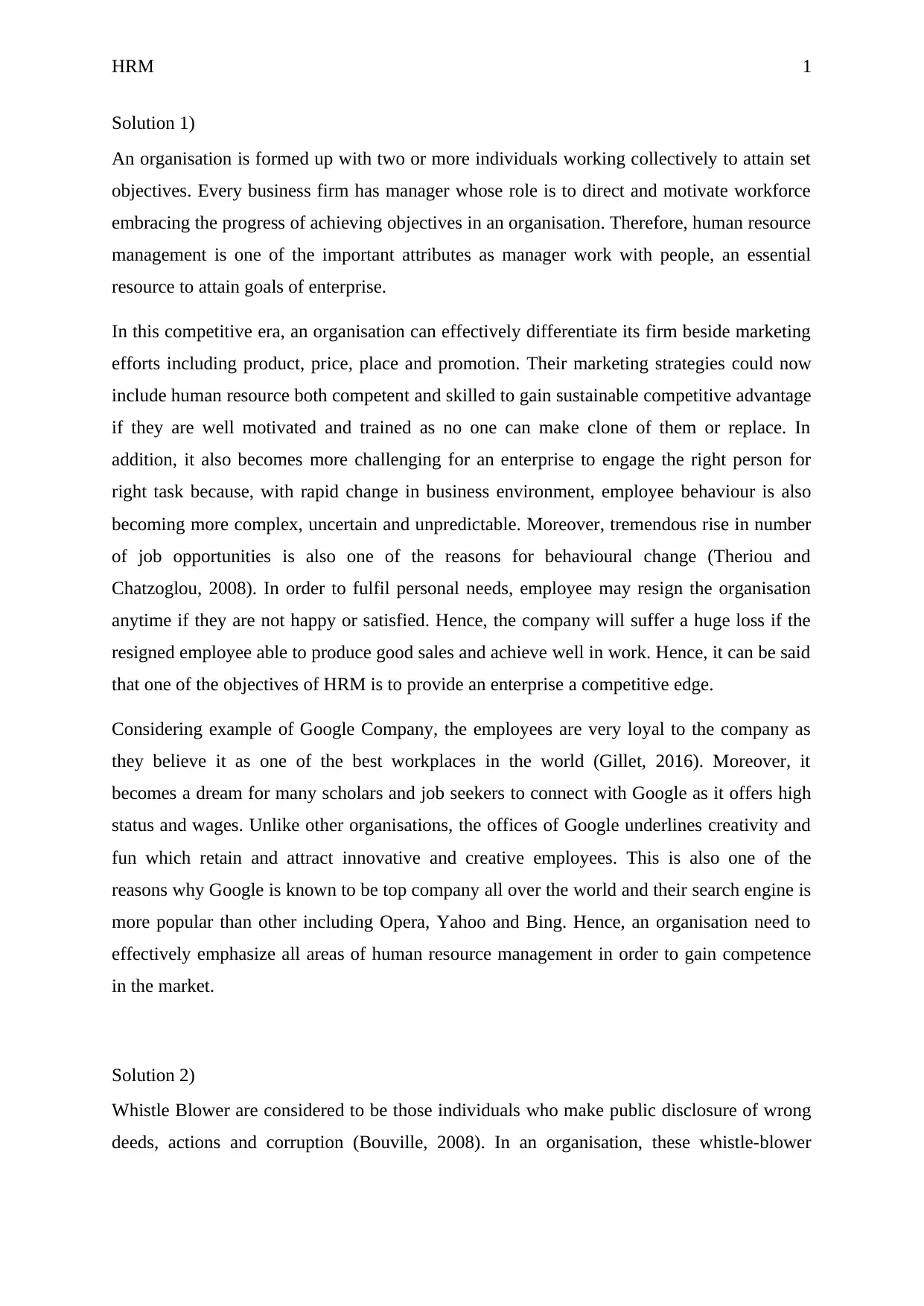
HRM 1
Solution 1)
An organisation is formed up with two or more individuals working collectively to attain set
objectives. Every business firm has manager whose role is to direct and motivate workforce
embracing the progress of achieving objectives in an organisation. Therefore, human resource
management is one of the important attributes as manager work with people, an essential
resource to attain goals of enterprise.
In this competitive era, an organisation can effectively differentiate its firm beside marketing
efforts including product, price, place and promotion. Their marketing strategies could now
include human resource both competent and skilled to gain sustainable competitive advantage
if they are well motivated and trained as no one can make clone of them or replace. In
addition, it also becomes more challenging for an enterprise to engage the right person for
right task because, with rapid change in business environment, employee behaviour is also
becoming more complex, uncertain and unpredictable. Moreover, tremendous rise in number
of job opportunities is also one of the reasons for behavioural change (Theriou and
Chatzoglou, 2008). In order to fulfil personal needs, employee may resign the organisation
anytime if they are not happy or satisfied. Hence, the company will suffer a huge loss if the
resigned employee able to produce good sales and achieve well in work. Hence, it can be said
that one of the objectives of HRM is to provide an enterprise a competitive edge.
Considering example of Google Company, the employees are very loyal to the company as
they believe it as one of the best workplaces in the world (Gillet, 2016). Moreover, it
becomes a dream for many scholars and job seekers to connect with Google as it offers high
status and wages. Unlike other organisations, the offices of Google underlines creativity and
fun which retain and attract innovative and creative employees. This is also one of the
reasons why Google is known to be top company all over the world and their search engine is
more popular than other including Opera, Yahoo and Bing. Hence, an organisation need to
effectively emphasize all areas of human resource management in order to gain competence
in the market.
Solution 2)
Whistle Blower are considered to be those individuals who make public disclosure of wrong
deeds, actions and corruption (Bouville, 2008). In an organisation, these whistle-blower
Solution 1)
An organisation is formed up with two or more individuals working collectively to attain set
objectives. Every business firm has manager whose role is to direct and motivate workforce
embracing the progress of achieving objectives in an organisation. Therefore, human resource
management is one of the important attributes as manager work with people, an essential
resource to attain goals of enterprise.
In this competitive era, an organisation can effectively differentiate its firm beside marketing
efforts including product, price, place and promotion. Their marketing strategies could now
include human resource both competent and skilled to gain sustainable competitive advantage
if they are well motivated and trained as no one can make clone of them or replace. In
addition, it also becomes more challenging for an enterprise to engage the right person for
right task because, with rapid change in business environment, employee behaviour is also
becoming more complex, uncertain and unpredictable. Moreover, tremendous rise in number
of job opportunities is also one of the reasons for behavioural change (Theriou and
Chatzoglou, 2008). In order to fulfil personal needs, employee may resign the organisation
anytime if they are not happy or satisfied. Hence, the company will suffer a huge loss if the
resigned employee able to produce good sales and achieve well in work. Hence, it can be said
that one of the objectives of HRM is to provide an enterprise a competitive edge.
Considering example of Google Company, the employees are very loyal to the company as
they believe it as one of the best workplaces in the world (Gillet, 2016). Moreover, it
becomes a dream for many scholars and job seekers to connect with Google as it offers high
status and wages. Unlike other organisations, the offices of Google underlines creativity and
fun which retain and attract innovative and creative employees. This is also one of the
reasons why Google is known to be top company all over the world and their search engine is
more popular than other including Opera, Yahoo and Bing. Hence, an organisation need to
effectively emphasize all areas of human resource management in order to gain competence
in the market.
Solution 2)
Whistle Blower are considered to be those individuals who make public disclosure of wrong
deeds, actions and corruption (Bouville, 2008). In an organisation, these whistle-blower
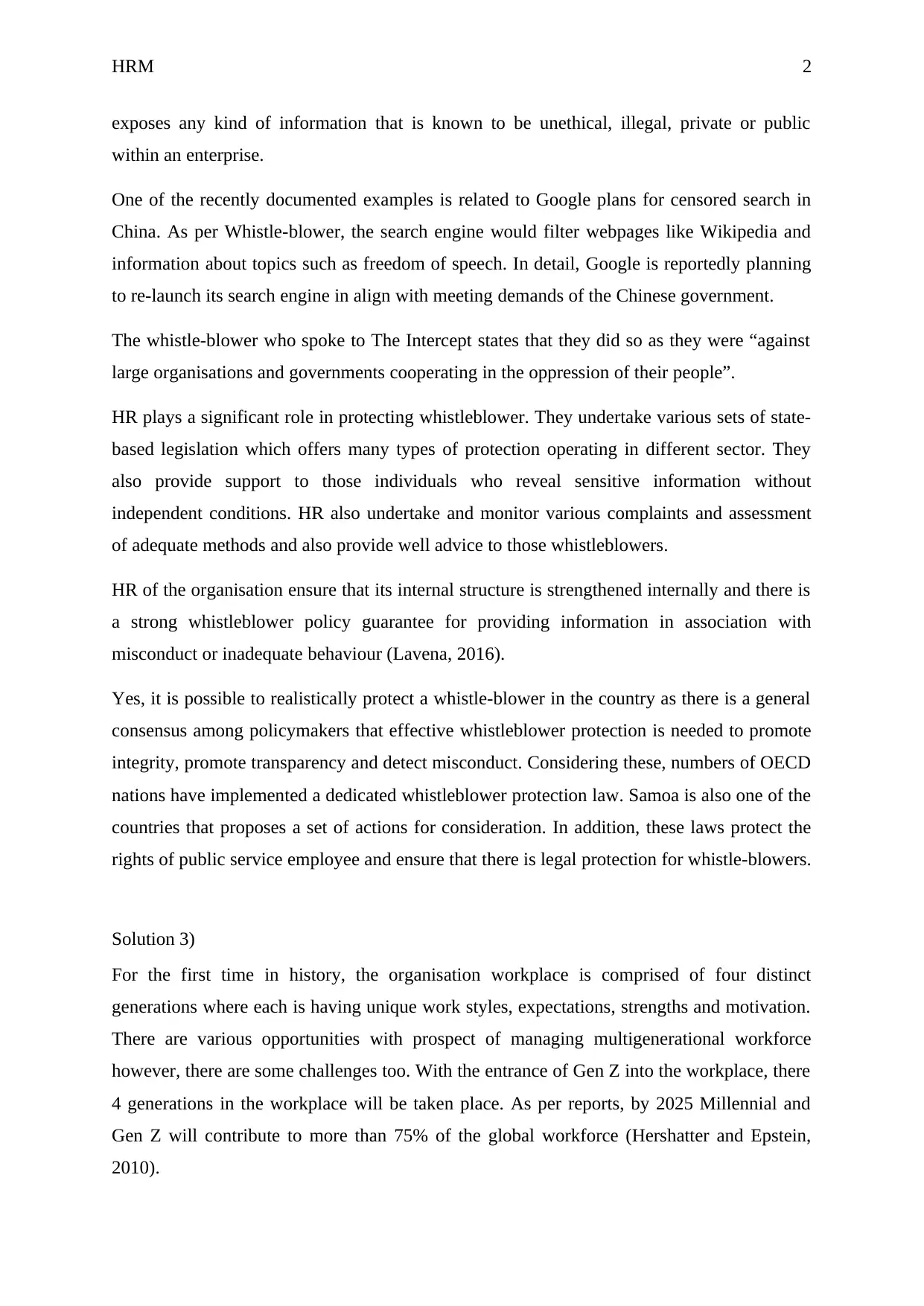
HRM 2
exposes any kind of information that is known to be unethical, illegal, private or public
within an enterprise.
One of the recently documented examples is related to Google plans for censored search in
China. As per Whistle-blower, the search engine would filter webpages like Wikipedia and
information about topics such as freedom of speech. In detail, Google is reportedly planning
to re-launch its search engine in align with meeting demands of the Chinese government.
The whistle-blower who spoke to The Intercept states that they did so as they were “against
large organisations and governments cooperating in the oppression of their people”.
HR plays a significant role in protecting whistleblower. They undertake various sets of state-
based legislation which offers many types of protection operating in different sector. They
also provide support to those individuals who reveal sensitive information without
independent conditions. HR also undertake and monitor various complaints and assessment
of adequate methods and also provide well advice to those whistleblowers.
HR of the organisation ensure that its internal structure is strengthened internally and there is
a strong whistleblower policy guarantee for providing information in association with
misconduct or inadequate behaviour (Lavena, 2016).
Yes, it is possible to realistically protect a whistle-blower in the country as there is a general
consensus among policymakers that effective whistleblower protection is needed to promote
integrity, promote transparency and detect misconduct. Considering these, numbers of OECD
nations have implemented a dedicated whistleblower protection law. Samoa is also one of the
countries that proposes a set of actions for consideration. In addition, these laws protect the
rights of public service employee and ensure that there is legal protection for whistle-blowers.
Solution 3)
For the first time in history, the organisation workplace is comprised of four distinct
generations where each is having unique work styles, expectations, strengths and motivation.
There are various opportunities with prospect of managing multigenerational workforce
however, there are some challenges too. With the entrance of Gen Z into the workplace, there
4 generations in the workplace will be taken place. As per reports, by 2025 Millennial and
Gen Z will contribute to more than 75% of the global workforce (Hershatter and Epstein,
2010).
exposes any kind of information that is known to be unethical, illegal, private or public
within an enterprise.
One of the recently documented examples is related to Google plans for censored search in
China. As per Whistle-blower, the search engine would filter webpages like Wikipedia and
information about topics such as freedom of speech. In detail, Google is reportedly planning
to re-launch its search engine in align with meeting demands of the Chinese government.
The whistle-blower who spoke to The Intercept states that they did so as they were “against
large organisations and governments cooperating in the oppression of their people”.
HR plays a significant role in protecting whistleblower. They undertake various sets of state-
based legislation which offers many types of protection operating in different sector. They
also provide support to those individuals who reveal sensitive information without
independent conditions. HR also undertake and monitor various complaints and assessment
of adequate methods and also provide well advice to those whistleblowers.
HR of the organisation ensure that its internal structure is strengthened internally and there is
a strong whistleblower policy guarantee for providing information in association with
misconduct or inadequate behaviour (Lavena, 2016).
Yes, it is possible to realistically protect a whistle-blower in the country as there is a general
consensus among policymakers that effective whistleblower protection is needed to promote
integrity, promote transparency and detect misconduct. Considering these, numbers of OECD
nations have implemented a dedicated whistleblower protection law. Samoa is also one of the
countries that proposes a set of actions for consideration. In addition, these laws protect the
rights of public service employee and ensure that there is legal protection for whistle-blowers.
Solution 3)
For the first time in history, the organisation workplace is comprised of four distinct
generations where each is having unique work styles, expectations, strengths and motivation.
There are various opportunities with prospect of managing multigenerational workforce
however, there are some challenges too. With the entrance of Gen Z into the workplace, there
4 generations in the workplace will be taken place. As per reports, by 2025 Millennial and
Gen Z will contribute to more than 75% of the global workforce (Hershatter and Epstein,
2010).
⊘ This is a preview!⊘
Do you want full access?
Subscribe today to unlock all pages.

Trusted by 1+ million students worldwide
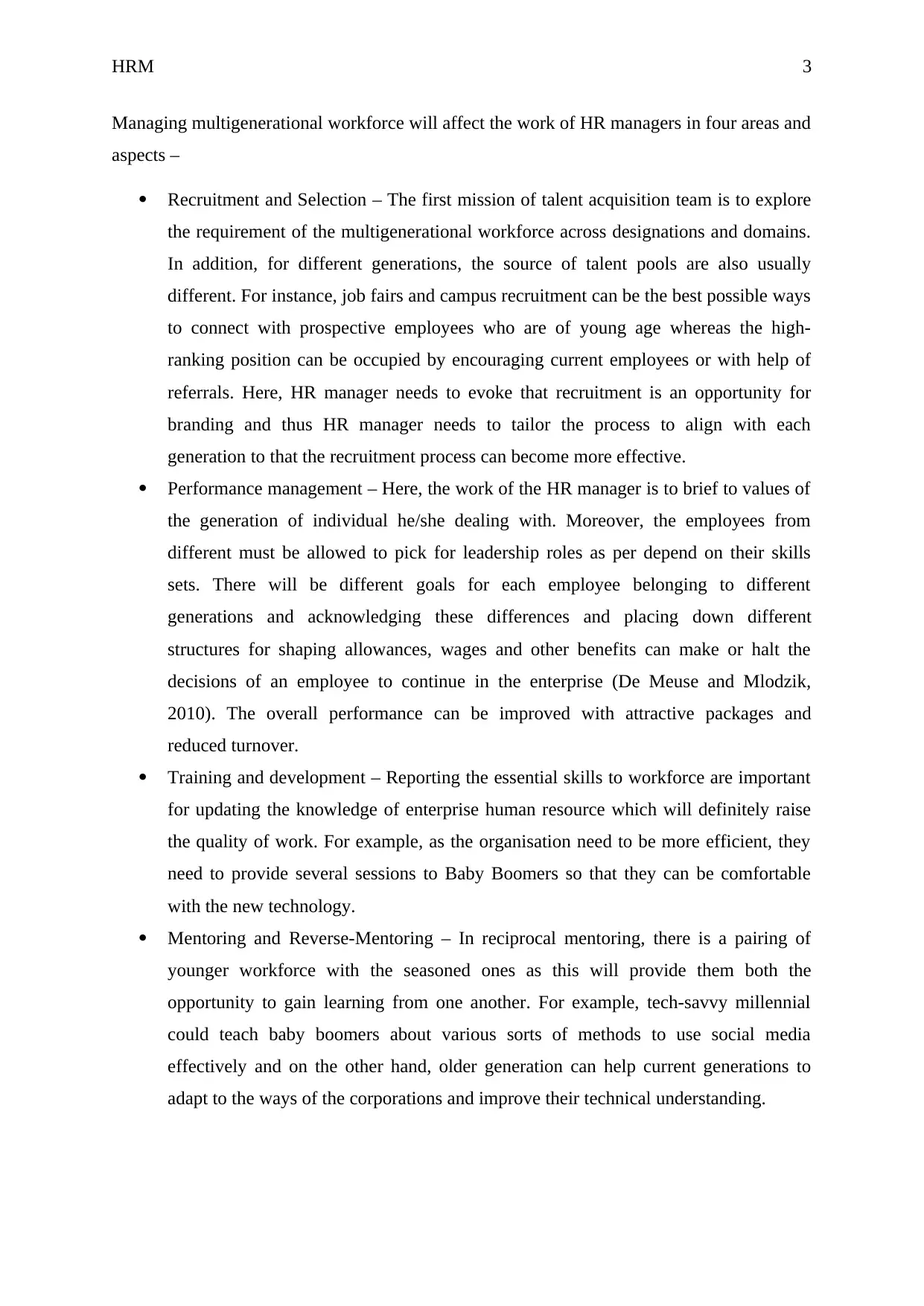
HRM 3
Managing multigenerational workforce will affect the work of HR managers in four areas and
aspects –
Recruitment and Selection – The first mission of talent acquisition team is to explore
the requirement of the multigenerational workforce across designations and domains.
In addition, for different generations, the source of talent pools are also usually
different. For instance, job fairs and campus recruitment can be the best possible ways
to connect with prospective employees who are of young age whereas the high-
ranking position can be occupied by encouraging current employees or with help of
referrals. Here, HR manager needs to evoke that recruitment is an opportunity for
branding and thus HR manager needs to tailor the process to align with each
generation to that the recruitment process can become more effective.
Performance management – Here, the work of the HR manager is to brief to values of
the generation of individual he/she dealing with. Moreover, the employees from
different must be allowed to pick for leadership roles as per depend on their skills
sets. There will be different goals for each employee belonging to different
generations and acknowledging these differences and placing down different
structures for shaping allowances, wages and other benefits can make or halt the
decisions of an employee to continue in the enterprise (De Meuse and Mlodzik,
2010). The overall performance can be improved with attractive packages and
reduced turnover.
Training and development – Reporting the essential skills to workforce are important
for updating the knowledge of enterprise human resource which will definitely raise
the quality of work. For example, as the organisation need to be more efficient, they
need to provide several sessions to Baby Boomers so that they can be comfortable
with the new technology.
Mentoring and Reverse-Mentoring – In reciprocal mentoring, there is a pairing of
younger workforce with the seasoned ones as this will provide them both the
opportunity to gain learning from one another. For example, tech-savvy millennial
could teach baby boomers about various sorts of methods to use social media
effectively and on the other hand, older generation can help current generations to
adapt to the ways of the corporations and improve their technical understanding.
Managing multigenerational workforce will affect the work of HR managers in four areas and
aspects –
Recruitment and Selection – The first mission of talent acquisition team is to explore
the requirement of the multigenerational workforce across designations and domains.
In addition, for different generations, the source of talent pools are also usually
different. For instance, job fairs and campus recruitment can be the best possible ways
to connect with prospective employees who are of young age whereas the high-
ranking position can be occupied by encouraging current employees or with help of
referrals. Here, HR manager needs to evoke that recruitment is an opportunity for
branding and thus HR manager needs to tailor the process to align with each
generation to that the recruitment process can become more effective.
Performance management – Here, the work of the HR manager is to brief to values of
the generation of individual he/she dealing with. Moreover, the employees from
different must be allowed to pick for leadership roles as per depend on their skills
sets. There will be different goals for each employee belonging to different
generations and acknowledging these differences and placing down different
structures for shaping allowances, wages and other benefits can make or halt the
decisions of an employee to continue in the enterprise (De Meuse and Mlodzik,
2010). The overall performance can be improved with attractive packages and
reduced turnover.
Training and development – Reporting the essential skills to workforce are important
for updating the knowledge of enterprise human resource which will definitely raise
the quality of work. For example, as the organisation need to be more efficient, they
need to provide several sessions to Baby Boomers so that they can be comfortable
with the new technology.
Mentoring and Reverse-Mentoring – In reciprocal mentoring, there is a pairing of
younger workforce with the seasoned ones as this will provide them both the
opportunity to gain learning from one another. For example, tech-savvy millennial
could teach baby boomers about various sorts of methods to use social media
effectively and on the other hand, older generation can help current generations to
adapt to the ways of the corporations and improve their technical understanding.
Paraphrase This Document
Need a fresh take? Get an instant paraphrase of this document with our AI Paraphraser
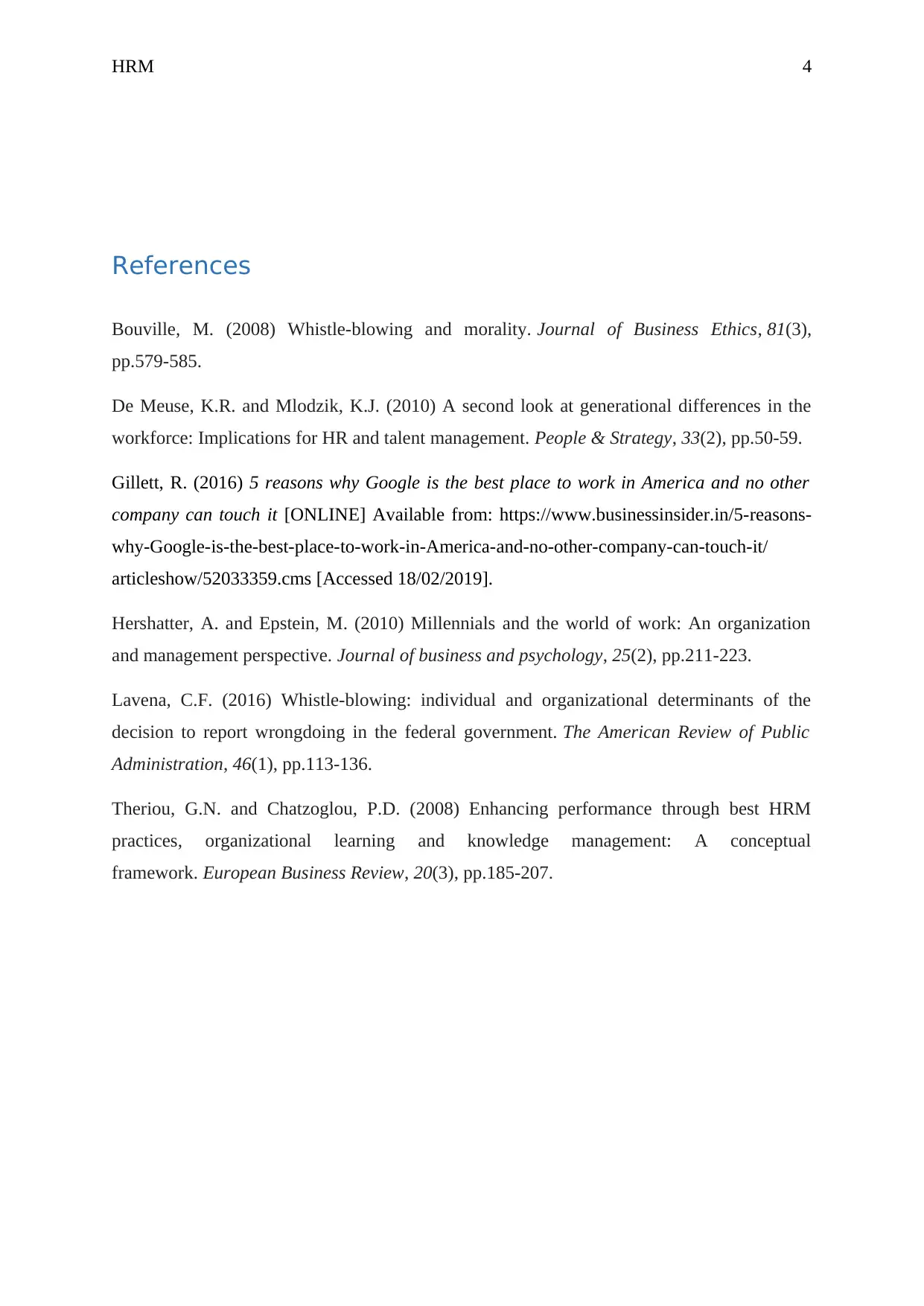
HRM 4
References
Bouville, M. (2008) Whistle-blowing and morality. Journal of Business Ethics, 81(3),
pp.579-585.
De Meuse, K.R. and Mlodzik, K.J. (2010) A second look at generational differences in the
workforce: Implications for HR and talent management. People & Strategy, 33(2), pp.50-59.
Gillett, R. (2016) 5 reasons why Google is the best place to work in America and no other
company can touch it [ONLINE] Available from: https://www.businessinsider.in/5-reasons-
why-Google-is-the-best-place-to-work-in-America-and-no-other-company-can-touch-it/
articleshow/52033359.cms [Accessed 18/02/2019].
Hershatter, A. and Epstein, M. (2010) Millennials and the world of work: An organization
and management perspective. Journal of business and psychology, 25(2), pp.211-223.
Lavena, C.F. (2016) Whistle-blowing: individual and organizational determinants of the
decision to report wrongdoing in the federal government. The American Review of Public
Administration, 46(1), pp.113-136.
Theriou, G.N. and Chatzoglou, P.D. (2008) Enhancing performance through best HRM
practices, organizational learning and knowledge management: A conceptual
framework. European Business Review, 20(3), pp.185-207.
References
Bouville, M. (2008) Whistle-blowing and morality. Journal of Business Ethics, 81(3),
pp.579-585.
De Meuse, K.R. and Mlodzik, K.J. (2010) A second look at generational differences in the
workforce: Implications for HR and talent management. People & Strategy, 33(2), pp.50-59.
Gillett, R. (2016) 5 reasons why Google is the best place to work in America and no other
company can touch it [ONLINE] Available from: https://www.businessinsider.in/5-reasons-
why-Google-is-the-best-place-to-work-in-America-and-no-other-company-can-touch-it/
articleshow/52033359.cms [Accessed 18/02/2019].
Hershatter, A. and Epstein, M. (2010) Millennials and the world of work: An organization
and management perspective. Journal of business and psychology, 25(2), pp.211-223.
Lavena, C.F. (2016) Whistle-blowing: individual and organizational determinants of the
decision to report wrongdoing in the federal government. The American Review of Public
Administration, 46(1), pp.113-136.
Theriou, G.N. and Chatzoglou, P.D. (2008) Enhancing performance through best HRM
practices, organizational learning and knowledge management: A conceptual
framework. European Business Review, 20(3), pp.185-207.
1 out of 5
Related Documents
Your All-in-One AI-Powered Toolkit for Academic Success.
+13062052269
info@desklib.com
Available 24*7 on WhatsApp / Email
![[object Object]](/_next/static/media/star-bottom.7253800d.svg)
Unlock your academic potential
Copyright © 2020–2025 A2Z Services. All Rights Reserved. Developed and managed by ZUCOL.





